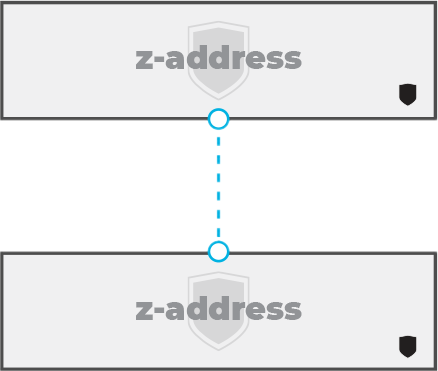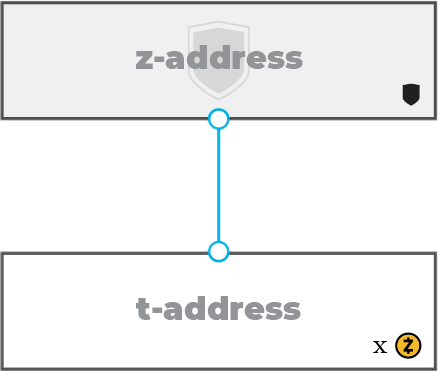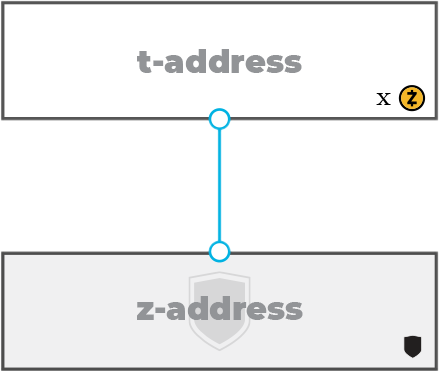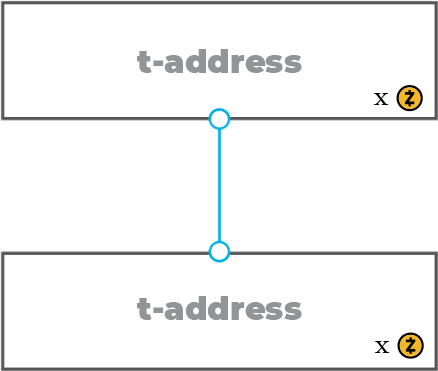Addresses and Value Pools in Zcash¶
Addresses Overview¶
Zcash has two main types of addresses: shielded (z-addresses which start with “z”) and transparent (t-addresses which start with “t”).
The Sapling network upgrade added a new type of shielded address to support the usability and security improvements. The new Sapling shielded addresses start with “zs” whereas the legacy, Sprout shielded addresses start with “zc”.
Example addresses:
Sapling:
zs1z7rejlpsa98s2rrrfkwmaxu53e4ue0ulcrw0h4x5g8jl04tak0d3mm47vdtahatqrlkngh9slyLegacy:
zcU1Cd6zYyZCd2VJF8yKgmzjxdiiU1rgTTjEwoN1CGUWCziPkUTXUjXmX7TMqdMNsTfuiGN1jQoVN4kGxUR4sAPN4XZ7pxbTransparent:
t14oHp2v54vfmdgQ3v3SNuQga8JKHTNi2a1
ZEC can be sent between transparent and shielded addresses. Therefore, there are four basic types of transactions:

Shielded/private (Value is not revealed on the blockchain)¶

Deshielding (Value is revealed on the receiver end)¶

Shielding (Value is revealed on the sender end)¶

Transparent/public (Value is revealed by both sender and receiver)¶
Shielded Addresses¶
Shielded addresses are the address type that use zero-knowledge proofs to allow transaction data to be encrypted but remain verifiable by network nodes. Sapling shielded addresses are the primary shielded addresses as of the Sapling network upgrade activation. The legacy, Sprout addresses are still supported but will likely be deprecated in future. To learn about migrating from Sprout to Sapling addresses, see Sprout-to-Sapling Migration documentation.

Shielded addresses and the values sent to or from them are not publicly visible.¶
A transaction between two shielded addresses (a shielded transaction) keeps the addresses, transaction amount and the memo field shielded from the public (with the exception of migrating funds between Sprout and Sapling shielded addresses).
Senders to a shielded address may or may not include an encrypted memo.
Recipients of a shielded or deshielding transaction do not learn about the senders address through the transaction recipt in their wallet. The receivers only learn the value sent to their address(es) and if receiving to shielded addresses, any encrypted memo that may have been included by the sender.
Many wallets do not include shielded address support yet but this is expected to change over time with the adoption of Sapling addresses.
Transaction fees are visible regardless of sending to and/or receiving from shielded addresses.
The transaction subsequent to a coinbase transaction (which is always to a transparent address) must be a shielding transaction.
HD Wallets¶
Sapling addresses support a hierarchical deterministic wallet structure. This allows a master wallet seed to be used as a backup method for all Sapling addresses in a wallet. See the blog post, Sapling in HD to understand more about how this feature is supported. Note that HD support is not enabled for Sprout or transparent addresses.
Viewing Keys¶
Viewing keys allow for the separation of spending and viewing permissions associated with shielded addresses. Users might want to give third-parties view access to their shielded addresses without also handing over spending capabilities or using a transparent address. For example, consider accounting or auditing use cases.
Currently, viewing keys are only partially supported in Sprout shielded addresses in the form of incoming viewing keys. This means, the viewing key will only be able to track incoming payments to a Sprout address. Sapling addresses do not have any viewing key support. This documentation will be updated when full Sapling address support is integrated.
Transparent Addresses¶
Transparent addresses work similarly to Bitcoin addresses and do not offer privacy for users.

Transparent addresses and the values sent to or from them are publicly visible¶
At this time, some advanced features such as multisignature and the use of bitcoin-style scripting with opcodes are only supported by transparent addresses. Multisignature addresses start with a “t3” as opposed to the single signature standard address which start with a “t1”.
Many wallets only support transparent addresses.
Coinbase transactions (AKA block rewards and miner fee payouts) can only be sent to transparent addresses.
Value Pools¶
Since there are 3 distinct address types (transparent, Sapling and Sprout), this means there are 3 value pools in which ZEC can be held. All ZEC held in transparent addresses are part of the transparent value pool, all ZEC held in Sapling addresses are part of the Sapling value pool and all ZEC held in Sprout addresses are part of the Sprout value pool. The sum of the pools is equal to the total amount of ZEC in circulation.
Checking the Value Pool Totals¶
It’s possible to use your own node to check the total value in each shielded value pool with a single RPC call to getblockchaininfo. One way to issue that is to call zcash-cli getblockchaininfo on a computer running a properly-functioning zcashd. The resulting JSON blob contains the perceived totals in the valuePool field. If the value corresponding with the “monitored” json key within the “Sprout” or “Sapling” entries are true, then your values for the pools are correct. If either of them are false, then your figures are wrong and you shouldn’t rely on them, and you will need to reindex your node with zcashd -reindex to turn “monitored” to “true” at which point you can trust those figures.
The value pools are also monitored at the third-party website zcha.in.
Turnstiles¶
For each shielded value pool (see above), there exists a turnstile which can calculate the expected amount of ZEC held in it. Since ZEC must be mined to a transparent address before being sent to any shielded address, the value entering either the Sprout or Sapling value pools is visible. Similarly, because ZEC cannot be sent directly between shielded value pools without revealing the amount (see: Sprout-to-Sapling Migration), the value exiting a shielded value pool is also visible. This allows for publicly tracking the total value held by shielded pools without having the ability to know individual shielded address balances.
As A Defense Mechanism Against Balance Violations¶
While maintaining proper balances in Zcash transactions are primarily checked through other means (such as zero-knowledge proofs), the turnstiles are a way to publicly validate this property on a per-value pool basis. From there, defensive measures can be implemented to contain balance violations within an affected value pool.
A new consensus rule in Zcash is being implemented for this very purpose. As defined in ZIP 209: Prohibit Negative Shielded Value Pool, the rule states:
> If the “Sprout value pool balance” or “Sapling value pool balance” were to become negative as a result of accepting a block, then all nodes MUST reject the block as invalid.
Additional Reading¶
Privacy Considerations for Official Zcash Software & Third-Party Wallets